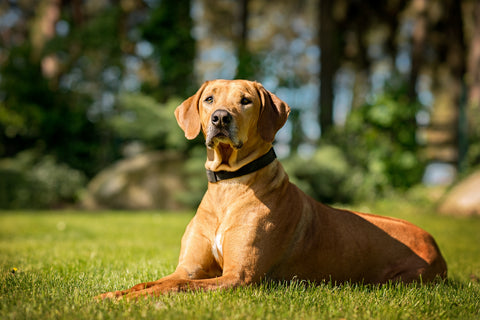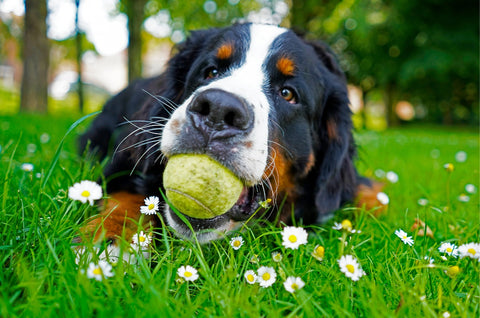
Many people choose a collar for their new dog. After all, it's what most of the dogs they see around town are probably wearing. And collars are available in a wide range of cool colors and styles. Want your pet to wear a glittery pink bow or a stylish polka-dotted bow tie? There's almost certainly a collar like that! In fact, there's a collar to fit just about any pooch (and owner's!) taste. However, you may want to add a harness to your dog's wardrobe for a variety of important health and safety reasons. Deciding to choose a harness can depend on the type of dog you have, his age, how big and/or strong he is, his activity level, his behavior, his level of training, how crowded the paths are, and other factors. Let's consider the pros and cons of a collar vs. a harness.
The Popular and Useful Dog Collar
Collars are popular because they can usually be left on the dog constantly, meaning your dog's important ID tags will always be with her. Dogs with sensitive skin who might object to wearing a harness all the time will generally accept a more minimalistic collar. A collar is also easier to get on and off vs. a harness when it's time for grooming. Your pup will also stay cooler and sleep more comfortably while wearing a collar instead of a harness.
Harnesses that are worn all of the time can cause chafing and other skin irritations, wear and tear on your pet's coat, and painfully matted hair. A good option is to leave a collar, and those all-important tags, on your dog all of the time and reserve the harness for trips out of the house. Your dog will probably thank you for it!

So should you consider a collar vs. a harness? Collars alone aren't suitable for some dogs when they leave the house. Dogs who can easily slip out of a collar (we're looking at you sighthounds!) and dogs that pull hard are better off wearing a harness along with their collar.
You see, a dog that repeatedly lunges against a collar can damage her trachea and other parts of her neck. She might also strain her neck muscles and potentially damage her spine. You'll still want your precious pooch to wear those ID tags, so leaving the collar on along with the harness will help ensure your dog's safety.
Risk of Damage From Using a Collar
According to Canine Kinetics, your dog may be at risk of damage from a collar if she:
- Has a sensitive neck or is at risk of cervical spinal damage.
- Has a hacking cough indicative of a damaged trachea.
- Pulls repeatedly, which can cause muscle strains or sprains and/or compression of the lymphatic system. Excessive pulling while wearing a collar can also significantly increase eye pressure and make existing eye problems like glaucoma worse.
- A brachycephalic breed or cross. These dogs tend to have breathing issues due to their smooshed faces and certainly don't need any additional pressure on their trachea (windpipe).
Jerking on a collar (either by your dog or you) can also cause compression and possible damage to the blood vessels, nerves, and thyroid gland in her neck.

Why Your Dog May Need a Harness
Is your dog's neck wider than his head? For a dog with a thick neck and narrow head, pulling off an escape is effortless while wearing a collar. He'll simply duck his head, lay his ears back, take a step or two backward, and he's off and running! A harness is harder (though not impossible!) for your four-legged Houdini to get out of.
A harness disperses pressure across a large portion of your pet's body, rather than a small section of his neck. This reduces the likelihood of injuring your dog if he jerks or pulls against the leash. Unfortunately, many harnesses encourage pulling by a dog. Think of sled dogs in harness to a sled as an example. Using a no-pull harness can stop your dog's pulling and avoid damage to his neck (and your shoulder and hand!) by redirecting him.
The leash is generally attached to the front of a no-pull harness rather than on top. When your dog pulls, he won't be able to use his powerful shoulder muscles to his advantage. Instead, the front attachment will curve his body to the side and put him slightly off balance. It's much harder to pull while in that position and your dog may just decide to give up playing tug of war with you and the leash as a result.
Make Sure Your Dog's Collar or Harness Fits Properly
When choosing a collar vs. a harness for your pet, make sure your choice fits properly. An improperly fitted collar can either let your pup escape or choke her. You should be able to fit two fingers (one finger for small dogs) between your dog's neck and a properly fitted collar. Any more and she can probably get it off. Any less and it may be putting too much pressure on those delicate neck muscles.
The same finger test applies to harnesses. You should be able to fit one or two fingers, depending upon your pet's size, between her chest and the harness. Also, make sure that the harness doesn't interfere with your pooch's natural range of motion. She should be able to fully extend her front legs without any pinching or other interference.

It's especially important to check the fit of a growing puppy. Too many owners fail to realize that the collar doesn't grow like your puppy's neck does. You must check the fit every week or so and adjust the collar as necessary. This way, you can ensure that the collar doesn't get embedded in your poor pup's neck as she grows.
When you decide to use a collar vs. a harness (or both) with your pet, make sure you use a strong, comfortable, hands-free leash for the greatest safety and control. Visit our Dog Blog for more helpful tips on walking, running, or hiking with your dog. And don't hesitate to send us a woof if you have any questions!






